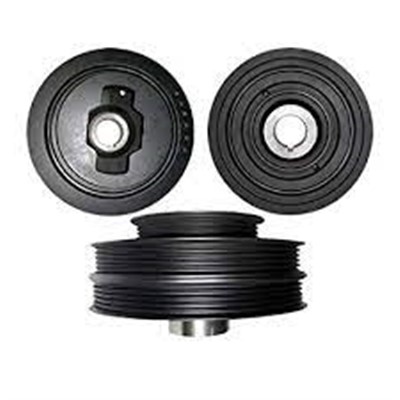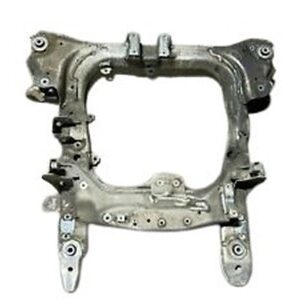Harmonic Balancer (Crank Pulley)
The Harmonic Balancer (Crank Pulley) stands as a pivotal component in automotive engineering, seamlessly marrying functionality with precision.
Crafted from a blend of robust metal and resilient rubber, this circular device finds its purpose at the forefront of the crankshaft. Its primary role lies in the adept absorption of vibrations, ensuring a smooth and stable engine performance.
Affixed to the crank pulley, this harmonious union extends its influence to drive essential accessories such as the air conditioner, amplifying its significance in the vehicle’s functionality.
Engineered for optimal efficiency, the internal rubber composition meticulously mitigates vibrations, maintaining an equilibrium that safeguards the engine’s integrity.
The Harmonic Balancer is not just a component; it’s a testament to innovative design and reliability, ensuring your automotive experience remains harmoniously balanced.
$198.00
CompareHarmonic Balancer (Crank Pulley)
The harmonic balancer (crank Pulley), also known as the crank pulley or vibration damper, is a critical component of an internal combustion engine. Its primary role is to reduce engine vibrations and prevent damage to the crankshaft and other engine components. By balancing and dampening vibrations, the harmonic balancer contributes to engine smoothness, longevity, and overall performance.
Material and Construction
Harmonic balancers are made from materials selected for their durability, strength, and vibration-damping properties:
- Cast Iron: Traditional Harmonic Balancers (Crank Pulley) are often made from cast iron, which provides strength and durability. Cast iron is effective at absorbing vibrations and handling high stresses.
- Aluminum: Some modern Harmonic Balancers(Crank Pulley) are constructed from aluminum or aluminum alloys. Aluminum provides a lightweight alternative while still offering good strength and vibration-damping capabilities.
- Rubber or Elastomer: The harmonic balancer includes a rubber or elastomeric ring, which is crucial for absorbing and dampening vibrations. This ring is located between the inner and outer sections of the balancer.
- Steel: The inner hub of the harmonic balancer is typically made from high-strength steel to handle the stresses imposed by the engine’s crankshaft.
Design and Functionality
The harmonic balancer is designed with several key features to ensure its effectiveness:
- Vibration Dampening: The primary function of the harmonic balancer is to absorb and dampen engine vibrations. It does this through its rubber or elastomeric ring, which helps to reduce the transmission of vibrations from the crankshaft to other engine components.
- Balancing: The harmonic balancer helps to balance the crankshaft by counteracting vibrations that could otherwise lead to engine damage. This balancing effect contributes to smoother engine operation and reduced wear on engine components.
- Crank Pulley: The harmonic balancer also serves as the crank pulley, providing a mounting point for accessories such as the serpentine belt, alternator, and power steering pump. It transmits power from the crankshaft to these accessories.
- Construction: The harmonic balancer consists of an inner hub, an outer ring, and a vibration-damping material between them. The outer ring is mounted on the crankshaft, while the inner hub is attached to the engine’s accessory drive system.
Performance and Benefits
The harmonic balancer contributes to several aspects of engine performance and reliability:
- Smooth Operation: By reducing engine vibrations, the harmonic balancer ensures smoother engine operation, which enhances overall driving comfort and reduces noise.
- Reduced Wear: Effective vibration dampening helps to reduce wear and tear on the crankshaft and other engine components. This contributes to improved engine longevity and reliability.
- Enhanced Efficiency: A well-functioning harmonic balancer (Crank Pulley) helps to maintain proper engine balance, which can improve fuel efficiency and engine performance.
- Accessory Drive: As a crank pulley, the harmonic balancer facilitates the operation of engine accessories, ensuring they function correctly and efficiently.
Maintenance and Care
Proper maintenance and care of the harmonic balancer (Crank Pulley) are essential for ensuring its effectiveness and preventing potential issues:
- Regular Inspection: Periodically inspect the harmonic balancer for signs of wear, such as cracks, separation of the rubber ring, or visible damage. Replace the balancer if any issues are detected.
- Listen for Noise: Pay attention to any unusual noises, such as rattling or squealing, which may indicate problems with the harmonic balancer. If you notice any abnormal sounds, have the balancer inspected by a professional.
- Check for Vibration: If you experience excessive engine vibration or rough operation, it may be a sign of a malfunctioning harmonic balancer. Have the balancer checked and replaced if necessary.
- Professional Servicing: If you suspect issues with the harmonic balancer or experience performance problems, consult a professional mechanic for inspection and replacement as needed.
Advanced Features and Technologies
Modern harmonic balancers may include advanced features to enhance their performance and functionality:
- Dual-Mass Design: Some Harmonic Balancers (Crank Pulley) use a dual-mass design, which provides enhanced vibration dampening and improved engine balance. This design can offer better performance and comfort.
- Integrated Sensors: In advanced engines, Harmonic Balancers (Crank Pulley) may include integrated sensors for monitoring vibration levels and engine performance. These sensors provide valuable data for diagnostics and maintenance.
- Performance Upgrades: High-performance vehicles may use upgraded harmonic balancers designed for improved vibration control and durability. These upgrades can enhance engine performance and reliability.
Conclusion
The harmonic balancer (crank pulley) is a vital component that plays a key role in reducing engine vibrations, balancing the crankshaft, and ensuring smooth engine operation. Its durable construction, effective vibration-damping properties, and functionality as a crank pulley contribute to engine performance and longevity. Regular maintenance and timely care of the harmonic balancer are important for preventing issues and maintaining optimal engine operation. By understanding the functions and benefits of the harmonic balancer, vehicle owners can ensure their engine operates smoothly and remains in excellent condition.
Based on 0 reviews
Be the first to review “Harmonic Balancer (Crank Pulley)” Cancel reply
Related products
-
Engine
Clutch Fork
0 out of 5(0)A clutch fork is an integral component within a vehicle’s clutch system, facilitating the seamless engagement and disengagement of the clutch.
Functioning as a critical link between the clutch pedal and the clutch throw-out bearing, the clutch fork translates the movement initiated by the clutch pedal into the necessary back-and-forth motions required for the clutch’s efficiency.
Crafted with precision, the fork plays a pivotal role in ensuring a smooth transition between gears, enhancing overall driving performance.
This high-quality clutch fork is designed to meet the stringent demands of modern automotive systems, offering reliability and durability across diverse driving conditions.
Its robust construction guarantees longevity, providing drivers with confidence in their vehicle’s clutch functionality.
Compatible with various vehicle makes and models, this clutch fork seamlessly integrates into different automotive systems, delivering consistent performance.
Trust in the superior design and engineering of this clutch fork, a key component contributing to the optimal functioning of your vehicle’s clutch system.
SKU: n/a -
Engine
Engine Oil Pan
0 out of 5(0)The engine oil pan is a vital component seamlessly integrated into your vehicle’s engine system.
Precision-engineered and crafted, it securely attaches to the engine’s underside using robust bolts, serving as the primary reservoir for oil.
As the heartbeat of your engine, this oil pan facilitates the efficient circulation of oil, ensuring optimal lubrication, cleanliness, and cooling of crucial moving parts.
During an oil change, the oil pan plays a pivotal role in the extraction and replenishment of engine oil, promoting longevity and peak performance.
Designed for compatibility with a variety of engine types, our oil pan exemplifies durability and reliability across all brands.
Engineered to exact standards, it enhances overall engine efficiency by reducing friction between components, mitigating heat generation, and promoting a cleaner, cooler engine environment.
Trust in the quality and versatility of our oil pan, a cornerstone of engine maintenance, whether you prefer conventional or synthetic oil.
Elevate your driving experience with a product designed to exceed expectations.
SKU: n/a -
Engine
Assault Racing Products PC2000 Small Block Chevy Polished Dual Plane Aluminum Intake
0 out of 5(0)This is a new satin aluminum dual plane intake for small block Chevy. A 180° high-rise design produces powerful output over a wide RPM range.
Ideal for everyday high-performance street applications, will produce power in the lower RPM range and not kill your bottom end like a single plane would.
Does not fit the newer Vortec heads. For use with square bore style carbs. Provides standard bosses and tapped holes for street accessories, accepts late model water neck, A/C and alternator brackets, and HEI. It also has a provision to add an early-style oil fill tube. Does not have a provision for manual choke and is not EGR equipped. Under the stock Corvette hood, it will not fit.
These intakes are produced from steel molds to reduce the core shift and have all the major features found on the expensive ones such as 4 corner water outlets, dual distributor hold-downs, and Nitrous bosses at a great price!
SKU: n/a -
Engine
Timing Chain
0 out of 5(0)Introducing our Precision Timing Chain, a vital component meticulously designed to synchronize the intricate dance between the crankshaft and camshaft(s) in your engine.
Crafted for optimal precision, this timing chain ensures seamless coordination, guaranteeing accurate timing for the precise opening and closing of engine valves during each cylinder’s firing cycle.
Built to withstand the rigors of engine dynamics, our timing chain boasts durability that exceeds industry standards.
Engineered for longevity, it operates within the heart of your engine, requiring periodic oil maintenance to ensure peak performance.
When it comes to reliability and efficiency, our timing chain stands as the epitome of excellence.
Experience the epitome of timing precision with our Timing Chain, a testament to engineering ingenuity. Our commitment is to deliver unrivaled performance, setting the benchmark for quality and durability in every rotation.
SKU: n/a -
Engine
Engine Cradle
0 out of 5(0)An engine cradle, also known as a “subframe,” stands as a vital structural cornerstone within the realm of unibody vehicles, the prevalent architecture in contemporary passenger vehicles.
This crucial component serves as a steadfast support system for the engine, transmission, and front suspension, ensuring optimal performance and structural integrity.
Often referred to as a rolling engine stand, the engine cradle seamlessly accommodates the mounting and maneuvering of engines, embodying a pivotal role in automotive maintenance and maneuverability.
Crafted with precision and durability, our engine cradle exemplifies engineering excellence, fostering stability and longevity.
Whether you’re navigating the urban landscape or tackling rugged terrains, our versatile engine cradle assures resilience and steadfast support, regardless of your vehicle’s make or model.
Elevate your driving experience with our reliable and meticulously designed engine cradle – an epitome of automotive innovation.
SKU: n/a









There are no reviews yet.